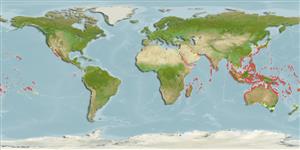Common names from other countries
Environment: milieu / climate zone / depth range / distribution range
Ecologie
; diepteverspreiding 1 - 40 m (Ref. 118675). Tropical
Indo-Pacific: from Red Sea to Cocos Island, Costa Rica, Japan to New Zealand. Tropical and temperate.
All reports of Charonia tritonis in the Mediterranean are Charonia variegata (Ref. 114477).
Length at first maturity / Size / Gewicht / Leeftijd
Maturity: Lm ? range ? - ? cm Max length : 50.0 cm SHL mannelijk/geslacht niet bekend; (Ref. 114242)
Feeds on sea stars and sea urchins, including crown-of-thorns starfish (Ref. 122680).
Life cycle and mating behavior
Geslachtsrijpheid | Voortplanting | Kuitschieten | Eieren | Fecundity | Larven
Members of the order Neotaenioglossa are mostly gonochoric and broadcast spawners. Life cycle: Embryos develop into planktonic trocophore larvae and later into juvenile veligers before becoming fully grown adults.
Smith, B.D. 2003. (Ref. 3116)
Status op de Rode Lijst van het IUCN (Ref. 130435)
Status bij CITES (Ref. 108899)
Not Evaluated
Not Evaluated
Gebruik door de mens
| FishSource |
Tools
Meer informatie
Leeftijd/Grootte
Groei
Lengte-gewicht parameters
Lengte-lengte parameters
Morfologie
Larven
Abundantie
Internet-bronnen
Estimates based on models
Preferred temperature
(Ref.
115969): 23.9 - 29.3, mean 27.9 (based on 1273 cells).
Prijsklasse
Unknown.
